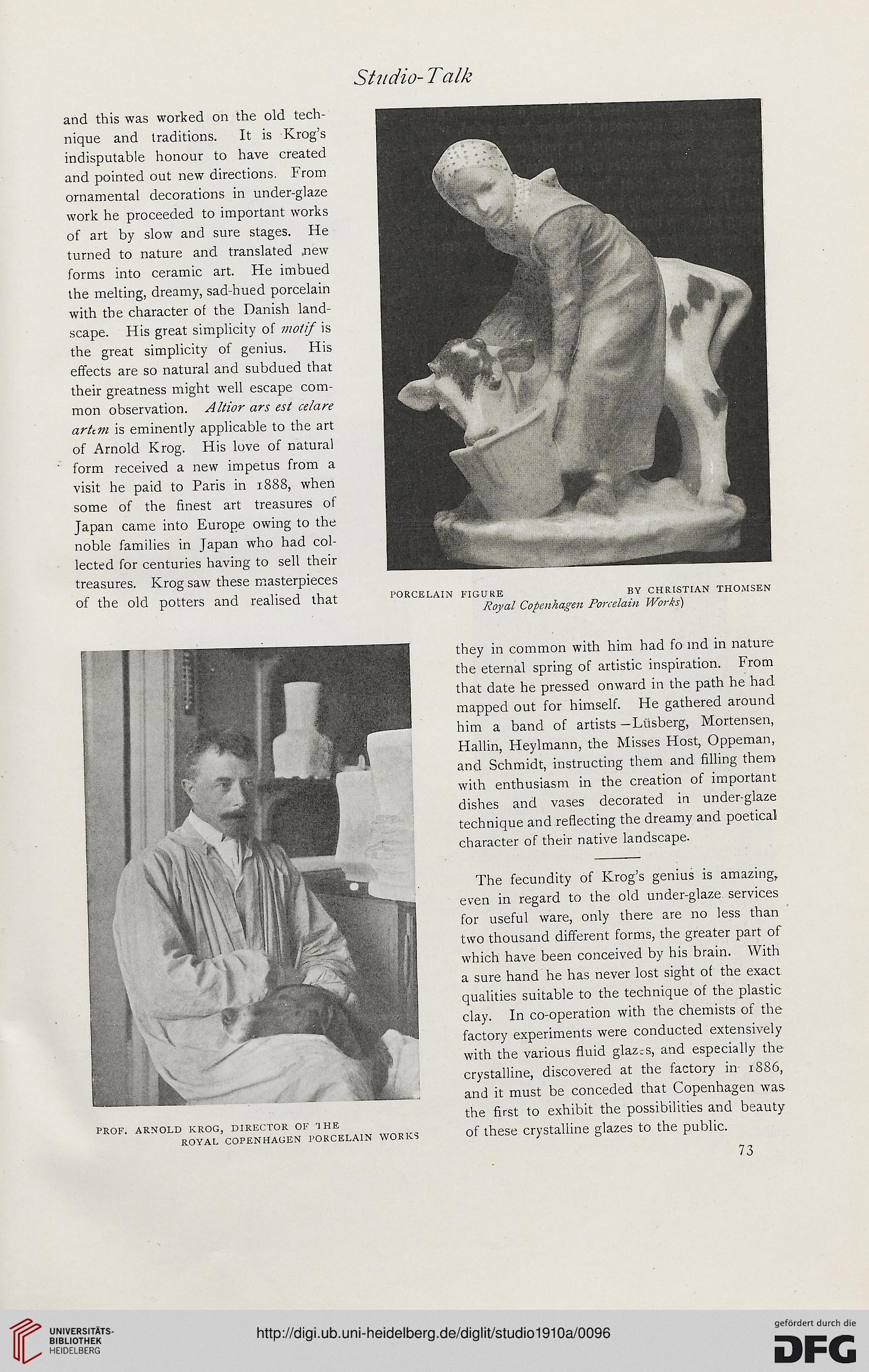Studio- Talk
and this was worked on the old tech-
nique and traditions. It is Krog’s
indisputable honour to have created
and pointed out new directions. From
ornamental decorations in under-glaze
work he proceeded to important works
of art by slow and sure stages. He
turned to nature and translated .new
forms into ceramic art. He imbued
the melting, dreamy, sad-hued porcelain
with the character of the Danish land-
scape. His great simplicity of molif is
the great simplicity of genius. His
effects are so natural and subdued that
their greatness might well escape com-
mon observation. Altior ars est celare
arU?ji is eminently applicable to the art
of Arnold Krog. His love of natural
form received a new impetus from a
visit he paid to Paris in 1888, when
some of the finest art treasures of
Japan came into Europe owing to the
noble families in Japan who had col-
lected for centuries having to sell their
treasures. Krog saw these masterpieces
of the old potters and realised that
PORCELAIN FIGURE BY CHRISTIAN THOMSEN
Royal Copenhagen Porcelain Works)
they in common with him had fo ind in nature
the eternal spring of artistic inspiration. From
that date he pressed onward in the path he had
mapped out for himself. He gathered around
him a band of artists —Ltisberg, Mortensen,
Hallin, Heylmann, the Misses Host, Oppeman,
and Schmidt, instructing them and filling them
with enthusiasm in the creation of important
dishes and vases decorated in under-glaze
technique and reflecting the dreamy and poetical
character of their native landscape.
The fecundity of Krog’s genius is amazing,
even in regard to the old under-glaze services
for useful ware, only there are no less than
two thousand different forms, the greater part of
which have been conceived by his brain. With
a sure hand he has never lost sight of the exact
qualities suitable to the technique of the plastic
clay. In co-operation with the chemists of the
factory experiments were conducted extensively
with the various fluid glaz;s, and especially the
crystalline, discovered at the factory in 1886,
and it must be conceded that Copenhagen was
the first to exhibit the possibilities and beauty
of these crystalline glazes to the public.
PROF. ARNOLD KROG, DIRECTOR OF 'I HE
ROYAL COPENHAGEN PORCELAIN WORKS
73
and this was worked on the old tech-
nique and traditions. It is Krog’s
indisputable honour to have created
and pointed out new directions. From
ornamental decorations in under-glaze
work he proceeded to important works
of art by slow and sure stages. He
turned to nature and translated .new
forms into ceramic art. He imbued
the melting, dreamy, sad-hued porcelain
with the character of the Danish land-
scape. His great simplicity of molif is
the great simplicity of genius. His
effects are so natural and subdued that
their greatness might well escape com-
mon observation. Altior ars est celare
arU?ji is eminently applicable to the art
of Arnold Krog. His love of natural
form received a new impetus from a
visit he paid to Paris in 1888, when
some of the finest art treasures of
Japan came into Europe owing to the
noble families in Japan who had col-
lected for centuries having to sell their
treasures. Krog saw these masterpieces
of the old potters and realised that
PORCELAIN FIGURE BY CHRISTIAN THOMSEN
Royal Copenhagen Porcelain Works)
they in common with him had fo ind in nature
the eternal spring of artistic inspiration. From
that date he pressed onward in the path he had
mapped out for himself. He gathered around
him a band of artists —Ltisberg, Mortensen,
Hallin, Heylmann, the Misses Host, Oppeman,
and Schmidt, instructing them and filling them
with enthusiasm in the creation of important
dishes and vases decorated in under-glaze
technique and reflecting the dreamy and poetical
character of their native landscape.
The fecundity of Krog’s genius is amazing,
even in regard to the old under-glaze services
for useful ware, only there are no less than
two thousand different forms, the greater part of
which have been conceived by his brain. With
a sure hand he has never lost sight of the exact
qualities suitable to the technique of the plastic
clay. In co-operation with the chemists of the
factory experiments were conducted extensively
with the various fluid glaz;s, and especially the
crystalline, discovered at the factory in 1886,
and it must be conceded that Copenhagen was
the first to exhibit the possibilities and beauty
of these crystalline glazes to the public.
PROF. ARNOLD KROG, DIRECTOR OF 'I HE
ROYAL COPENHAGEN PORCELAIN WORKS
73




